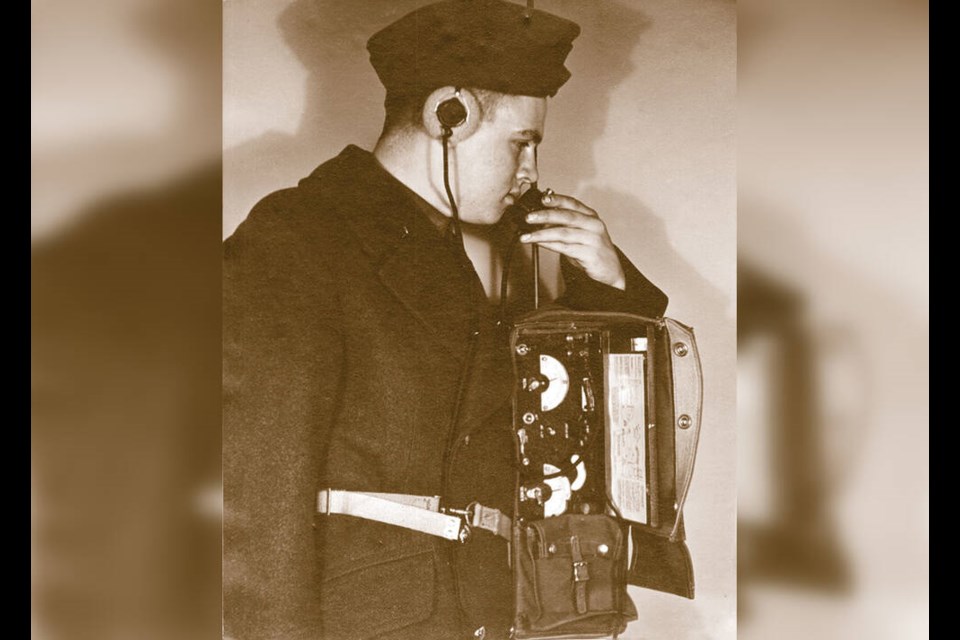Chesterfield House, designed by architect Henry Blackadder in 1913, is the former main house of the Chesterfield School for Boys, a British-styled institution run by headmaster, the Rev. John Newton Sykes. Now obscured by two carriage houses at its front, the house, which has been converted into apartments, is the last reminder of a once-prestigious school with multiple buildings and grounds at the corner of Chesterfield Avenue and Osborne Road.
We can be thankful for the attendance of one former pupil, the decorated communications pioneer and walkie-talkie inventor, Donald Hings.
Born in Leicester, England, Hings was only three when his mother migrated to Canada. Separated from her husband after a short-lived marriage, Winifred Mary Hings was tasked with bringing up a young boy on her own.
Initially, she and her son settled in Lethbridge, Alta. before relocating to Vancouver when Hings was about nine years old. Winifred found work as a bookkeeper with the British Columbia Electric Railway, while lodging at 646 West 10th St.
Hings attended Chesterfield School in North Vancouver, likely as a boarder. Crucially, given the direction his career was to take, he was introduced to wireless communications. By the age of 14 he had built his own crystal radio set. It was to be a lifelong interest that – coupled with his instinct for tinkering – would lead to amazing discoveries.
Hings was also a boy scout. His headmaster, Rev. Sykes, was volunteer fire chief of North Lonsdale and the school scout troop were his fire brigade. A hose reel station was situated 100 feet in from Lonsdale on St James East, and when the fire bell sounded, the boys would run with the hoses to nearby fires. It must have been an interesting sight. In the words of the historian Roy Pallant, “Not only were they unique in respect of [being] schoolboys, they were the only fire brigade in this whole area known to run with collars and ties on, and the fire chief having a clerical collar.”
Hings left Chesterfield after middle school, attending Lambert Technical School, where he took a two-year wireless communications course. As described to me by Hings’s daughter, Doreen, now age 88, Lambert was a small commercial school above a tailor’s shop on Hastings Street, between Vancouver’s downtown Woodward and Spenser’s department stores. It was to be the last of his formal education.
Walkie-talkie used by allied troops in Second World War
In his late teens, a land inheritance drew him and his mother to the interior near Rossland, B.C. Hings helped his mother, working as a labourer for a plywood company in Trail for several years, while pursuing his interest in radios. In 1930, he landed a job as a radio engineer at the Consolidated Mining and Smelting Company where he was given rein to develop his two-way radio, used by the company to communicate with its employees exploring by plane and on foot in the bush.
This revolutionary device was later called the walkie-talkie and was used by allied troops to communicate with each other during the Second World War. It was the catalyst for an illustrious career pioneering developments in communications, recognized after the war with the Order of the British Empire and, later in life, with the Order of Canada.
As a 10-year-old boy scout, Hings had stood on a tree stump on top of Capitol Hill, Burnaby while on a camping trip and decided this would be where he would live. Sure enough, after the war his vision became a reality. He bought an acre of land on the hill, built a house for his family, and established his research company where he worked for the next 50 years developing cutting edge technology in the fields of wireless communications, radar and geophysics.
From his early days, Hings was an enthusiastic HAM radio operator, using the call sign VE7BH. Doreen, his daughter, still has the licence plates he used for his car that carried the same number. As his long-time secretary in his laboratory at Capital Hill, she had first-hand insight into the numerous innovations and patents he created. In her words, Donald had an inquisitive mind and was always “measuring things” wherever he went to see how they worked.
His wife, Rakel would sometimes worry about the affordability of filing this seemingly never-ending stream of patents, stating that her husband didn’t follow up on them to ensure compliance. Hings, who was modest about his achievements, would reply that his job was to stay ahead of the competition.
The legacy of Chesterfield School can be proud of its former pupil, the hugely talented innovator, Donald Hings.
Paul Haston is an author of adult and children’s fiction, and an advocate at the North Shore Heritage Preservation Society, writing for its blog.




